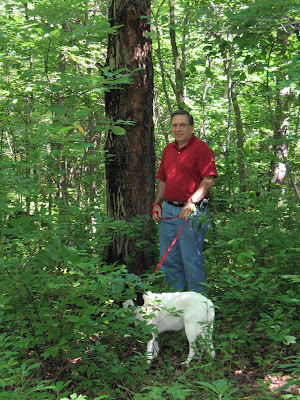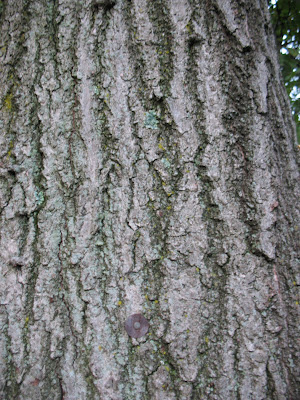Is your sleep disturbed by worries about disappearing spotted owls and snail darters? Maybe the objects of your concern are too grand. What you should really be worrying about is bugs: native bugs and the native plants that sustain them. That is the argument advanced by professor of entomology Douglas Tallamy in his recent book,
Bringing Nature Home: How Native Plants Sustain Wildlife in Our Gardens.(1) He says that we are starving our insects by replacing the native plants that they eat with exotic plants that they can't even recognize as food.

Native sweetbay magnolia. Native insect? Click to enlarge.
Starving the bugs sounds like a great idea, right? Maybe not. Tallamy presents insects as unloved heroes that transform the stored energy in plants into food (themselves) for the next level up in the food chain. In order to transform themselves into bird food, for example, insects must have food of their own to eat. But we are depriving them of food by replacing the native landscape with foreign plants. The vast majority of our insects are dietary specialists; the only foods they are capable of eating are members of the native plant community with which they have co-evolved over millions of years. Those are the foods to which their anatomy and physiology are adapted. They have as much success eating foreign plants as we would have if we tried to adopt the koala bear's diet of eucalyptus leaves. Without native plants, the insects have nothing they can eat, and they perish. With the insects gone, all of the food chain above insects will collapse.

American elm 1267 Park Avenue
The differences between the numbers of insects that can eat native versus foreign plants can be startling. Native oaks can provide food for over 500 different native insect species. Eucalyptus, an exotic, is eaten by only one native insect species. Native plants in Pennsylvania were found to support 35 times more caterpillar biomass, the preferred source of protein for most bird nestlings, than alien plants supported.

Native northern red oak, New Jersey state tree, West 8th St
How big a problem can this insect starvation be? Biodiversity depends on space. The more space, the larger the number of species that can be supported. The relationship is linear.(2) Only 3-5% of the lower 48 states remains undisturbed habitat for plants and animals. The rest has been paved, farmed, taken over by noxious foreign weeds like kudzu and Japanese honeysuckle, or transformed into suburban gardens dominated by exotic shrubs and vast lawns of non-native grasses. Tallamy points out that suburban lawns cover about 62,000 square miles of this country, an area more than eight times the size of New Jersey that is devoted to alien grasses.(3) Worse, 43,000 square miles of blacktop has been spread over the landscape, equal to five and a half New Jerseys. If we have eliminated much of the native vegetation from 95-97% of the American landscape, we can expect to lose 95-97% per cent of our native flora and fauna over time, as extinction adjusts the number of species to the land area that remains. Tallamy cites the toll of habitat destruction on Delaware, where he teaches. As of 2002, Delaware had lost 78% of its freshwater mussel species, 34% of its dragonflies, 20% of its fish species, and 31% of its reptiles and amphibians. Forty per cent of all native plant species in Delaware are threatened or already lost.

American holly East 9th Street
At this dismal point in his book Tallamy offers a ray of hope: suburban gardeners to the rescue! If suburbanites, who control a large swath of the landscape, were to plant native plants on their properties, the countryside could still support a diverse flora and fauna. Mix some American elms in with all those Zelkovas. Make your lawn smaller, and plant a meadow. Tear out some of your English ivy and Japanese pachysandra and plant mayapples. I repent ever having written that foreign, kousa dogwoods have the advantage of not being attacked by the borers that plague native flowering dogwoods (a good example of just what Tallamy is talking about). How petty of me ever to have planted exotic hollies instead of American hollies because of the Americans' problems with leaf miners! I'm going to be beating myself up for years over this. But as part of my rehabilitation program, I will spread the word about Tallamy's book, essential reading for anyone who plants.

Native black walnut leaf nibbled by, no doubt, native insects
(1) Tallamy, DW. Bringing Nature Home: How Native Plants Sustain Wildlife in Our Gardens. Timber Press, 2007.
(2) Tallamy cites the work of Michael Rosenzweig at the University of Arizona to support his claim that species diversity decreases in proportion to the loss of available space. His very cursory discussion of this important underpinning for his argument is, for me, the weakest part of his book. I would like to have seen Rosenzweig's data and analysis described in detail.
(3) If you would object that Kentucky bluegrass is a native, you would be mistaken. Its seeds were imported by European settlers in the digestive tracts and droppings of cattle.
Copyright Gregory Palermo






































